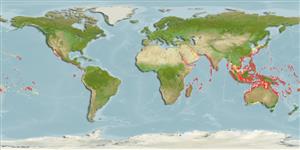Environment: milieu / climate zone / depth range / distribution range
Ecologie
marien; brak water rifbewoner; standvastig; diepte 1 - 50 m (Ref. 90102). Tropical; 25°C - ?; 36°N - 36°S, 24°E - 77°W
Indo-Pacific : Red Sea and East Africa (Ref. 4919) to Panama, north to southern Japan and the Hawaiian Islands, south to Lord Howe and Rapa islands. Eastern Pacific: Baja California and the Gulf of California to Panama (Ref. 9349, 11482).
Grootte / Gewicht / Leeftijd
Maturity: Lm ? range ? - ? cm
Max length : 50.0 cm TL mannelijk / geslacht onbekend; (Ref. 30874); max. gepubliceerd gewicht: 2.0 kg (Ref. 40637)
Dorsale stekels (totaal) : 0; Dorsale zachte stralen (totaal) : 10 - 11; Anale stekels: 0; Anale zachte stralen: 10 - 11. This species is characterized by the following: The body is generally greenish-brown in color, the back, sides and caudal fin profusely speckled with white spots, and the belly marked with white bars. A single bent lateral line. Body with small spines except around snout and caudal peduncle. Each nostril with two fleshy solid tentacles. Restricted gill opening.
Inhabit outer reef slopes to depths of at least 50 m, inner reef flats and lagoons. Juveniles common in weedy areas of estuaries (Ref. 4919). Also found in coastal bays and estuaries, usually near rocky reef or on sand-stretches between reefs with low algae-rubble reef to about 20 meters depth, or in shallow with sparse seagrass growth (Ref. 48637). Benthopelagic (Ref. 58302). Usually solitary and territorial on sandy to rubble areas. Feed on fleshy, calcareous, or coralline algae, detritus, mollusks, tunicates, sponges, corals, zoanthid anemones, crabs, tube worms and echinoderms (Ref. 1602).
Levenscyclus en paargedrag
Maturiteit | Voortplanting | Paaien | Eieren | Fecunditeit | Larven
Myers, R.F., 1991. Micronesian reef fishes. Second Ed. Coral Graphics, Barrigada, Guam. 298 p. (Ref. 1602)
Status op de Rode Lijst van het IUCN (Ref. 130435: Version 2024-1)
Gevaar voor de mens
Poisonous to eat (Ref. 4690)
Gebruik door de mens
Visserij: van minder commercieel belang; sportvis: ja; Aquarium: Commercieel
Tools
Speciale rapporten
Download XML
Internetbronnen
Estimates based on models
Preferred temperature (Ref.
123201): 23.7 - 29, mean 27.7 °C (based on 1504 cells).
Fylogenetische diversiteitsindex (Ref.
82804): PD
50 = 0.5000 [Uniqueness, from 0.5 = low to 2.0 = high].
Bayesian length-weight: a=0.03981 (0.02445 - 0.06482), b=2.82 (2.69 - 2.95), in cm total length, based on LWR estimates for this species & Genus-body shape (Ref.
93245).
Trofisch niveau (Ref.
69278): 3.2 ±0.0 se; based on diet studies.
Weerstandsvermogen (Ref.
120179): Gemiddeld, minimale populatieverdubbelingstijd 1,4-4,4 jaar (Preliminary K or Fecundity.).
Fishing Vulnerability (Ref.
59153): Moderate vulnerability (40 of 100).
Nutrients (Ref.
124155): Calcium = 33.9 [14.1, 86.4] mg/100g; Iron = 0.555 [0.297, 1.204] mg/100g; Protein = 18.6 [16.4, 20.7] %; Omega3 = 0.113 [0.059, 0.212] g/100g; Selenium = 37.1 [18.8, 80.3] μg/100g; VitaminA = 38.4 [10.4, 141.7] μg/100g; Zinc = 1.13 [0.76, 1.70] mg/100g (wet weight); based on
nutrient studies.
